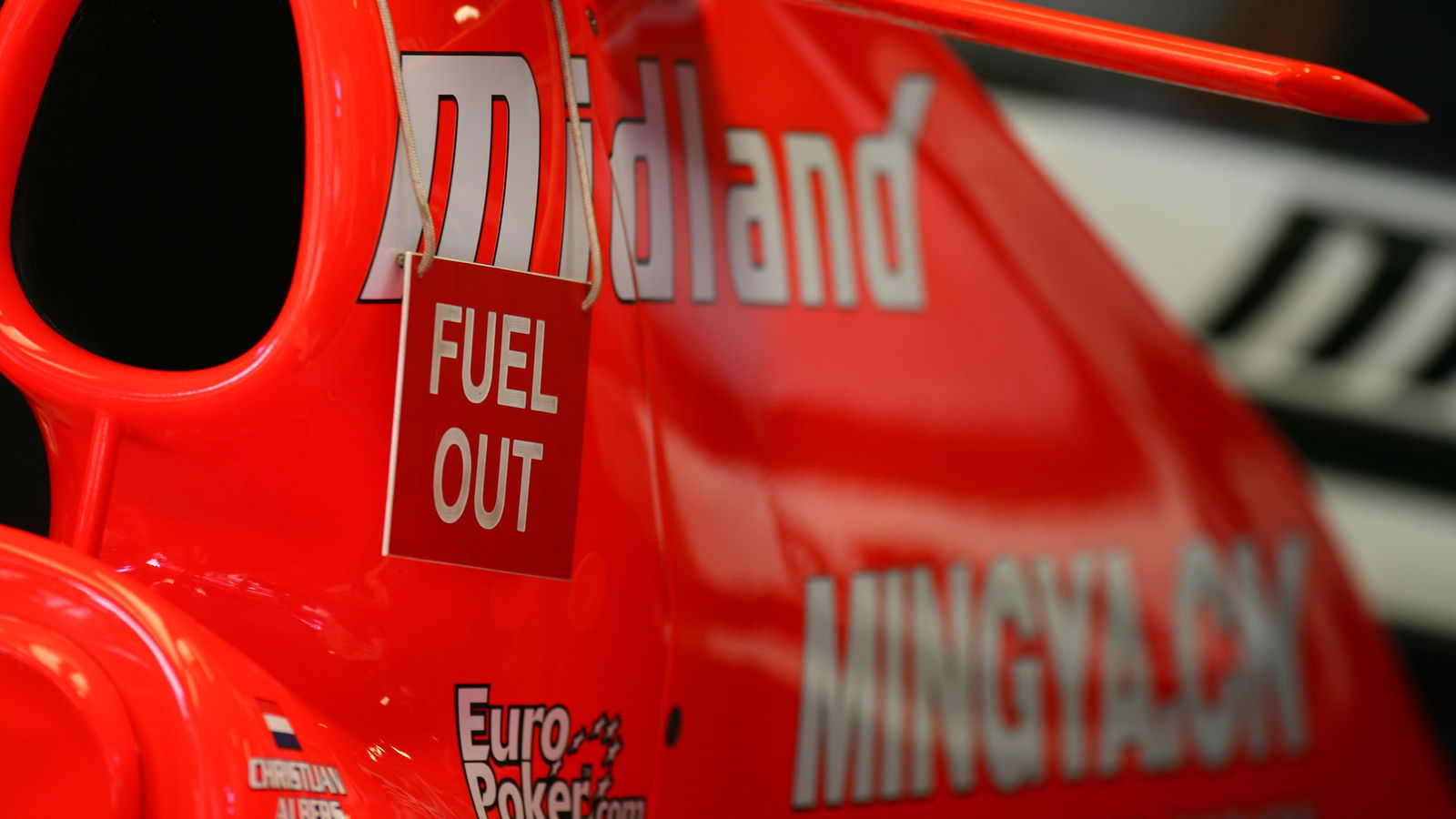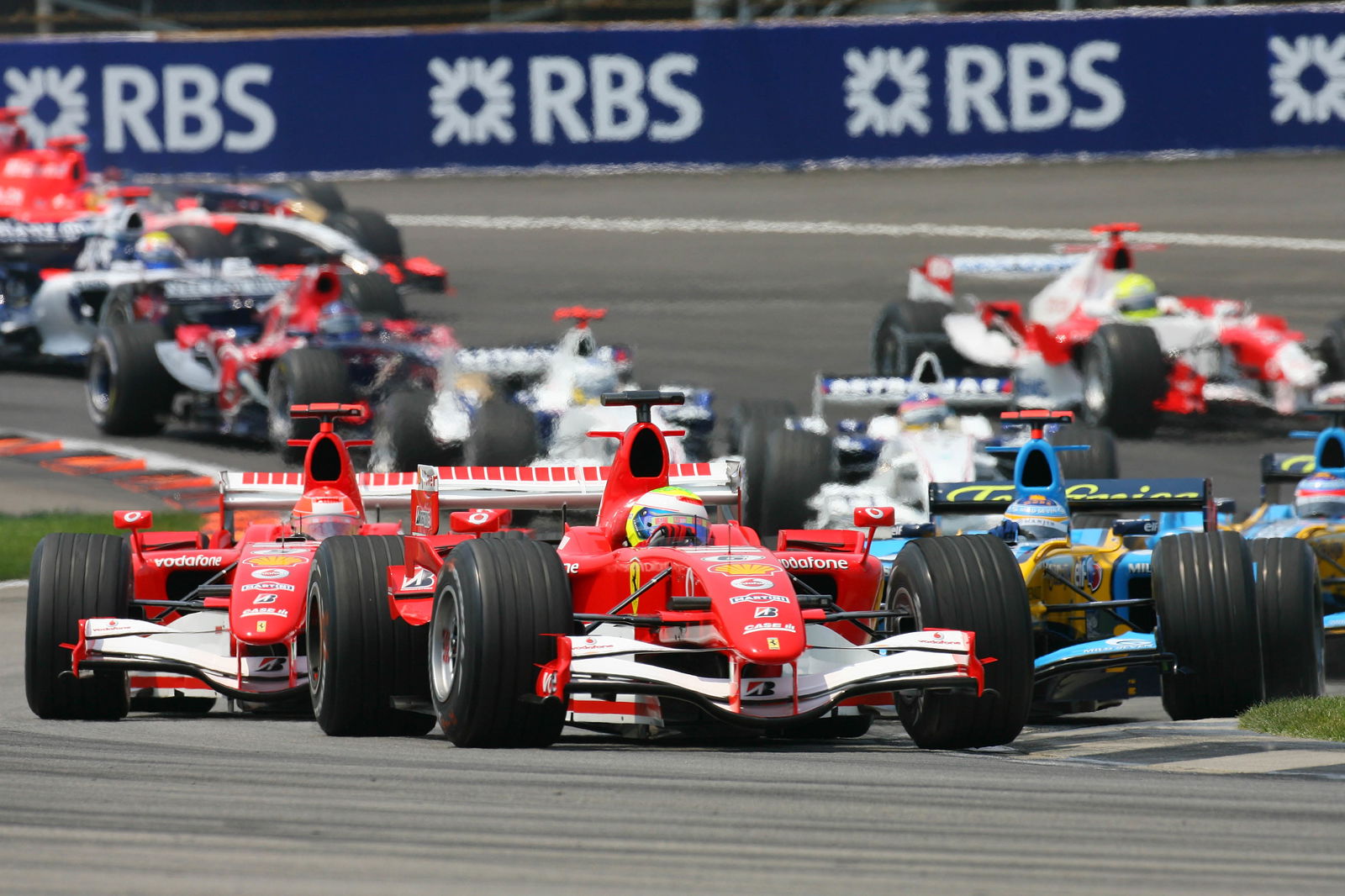Midland prove they are the IT team.
Information Technology - or 'IT', for short - now plays a role in almost every part of our lives and none more so than in Formula One.
There's a piece of IT-related equipment in almost every electrical item you use in your home or office, from your humble toaster to your state-of-the-art automobile. It's even present now in energy-saving light bulbs.
You are probably reading this text right now using a piece of IT equipment, and if not, you can be sure that an IT device has been used to apply ink to paper in order for you to read it.

Information Technology - or 'IT', for short - now plays a role in almost every part of our lives and none more so than in Formula One.
There's a piece of IT-related equipment in almost every electrical item you use in your home or office, from your humble toaster to your state-of-the-art automobile. It's even present now in energy-saving light bulbs.
You are probably reading this text right now using a piece of IT equipment, and if not, you can be sure that an IT device has been used to apply ink to paper in order for you to read it.
Given the prevalence of IT in our everyday lives, it is no surprise to learn that IT also plays a vital role in supporting and running the Midland F1 Racing team. Information Technology doesn't just mean looking after the dozens of laptop computers the team travels with, either - it encompasses all of MF1's power supplies, TV screens, networking, telephony, mobile communications solutions, and even the toner cartridges used in the printers.
MF1's Head of Information Technology, Adrian Collinson, leads a small but efficient team that provides a variety of IT services at the factory and wind tunnel in the UK, as well as to the race and test teams, wherever in the world they may be.
When asked which departments within the team rely on Information Technology to perform their role, Adrian breaks into a smile.
"It's easier to ask, 'Which departments don't rely on Information Technology?' The truth is that IT plays a role in every aspect of the company - from race car design, to part manufacturing, to stock control, accounting... Even the truckies use it for the layout of the garages. It's basically used for everything. IT is one of the many unsung heroes within any company."
Working with Adrian is David Lippiatt, who provides factory and test team support; Robert Hardwidge, who provides exclusive support to the race team; Katie Hanna, who looks after the first line help desk; and Jonathan Ruffley, who provides Computer Aided Design (CAD) support. Between the five of them, they look after more than 200 users within the team, which equates to roughly 300 physical desktops, laptops, and servers.
The team uses mainly standard, off-the-shelf computer kit as the backbone of its system, preferring instead to utilise specialised computing techniques rather than investing in expensive custom hardware. The big advantage to this strategy is that parts and spares are readily available, and are considerably cheaper than their custom-made equivalents.
"For example, let's look at some of the aerodynamic design done using Computational Fluid Dynamics (CFD), which is like running a virtual wind tunnel within the computer," explains Adrian. "You might want to analyse air flow over a wing or an air box. Although these computations require a massive amount of processing power, it's more a question of how you use specialist software than specialist hardware for that sort of work. The software we use splits the job into smaller chunks, which is then farmed out to individual machines that will solve that chunk and then bring the results back together. The computers used in this example are all standard workstations. For CAD design, we use the same machines, but fitted with high-end graphics cards."
"The more specialist hardware can be found on the back end," Adrian reveals. "All the team data has to be kept somewhere, so we have a SAN for data storage."
For the not-so-technical among us, SAN stands for Storage Area Network, and is basically a complicated collection of hard disk drives that are grouped together and available on a network. Such a setup entails all kinds of data security to ensure that the data is backed up in case of a disk failure.
"Of course, there's also some bespoke software in the wind tunnel, and we've got some bespoke software for strategy analysis," adds David Lippiatt.
"That's not the sort of software you're likely to find on the shelf of a software shop."
"In the garage, it gets even more specialised because of the unique environment," continues Adrian. "This year, for the first time, we're using some equipment from a company in the USA called Technology Advancement Group (TAG), which specialises in designing and building computer equipment for the military for operating in harsh environments. They produce a wide array of kit, ranging from servers to ruggedised laptops. Harsh environments are the extremes of conditions. In Bahrain, the extreme is heat and sand; in Malaysia, it's humidity.
"The computers we're using in the garage are designed to run in these environments. The design of the circuit boards and the cases are such that they can cope with much higher ambient temperatures. The ones in the garage are also coated internally so that they can withstand the carbon dust that is present in an F1 garage. Carbon, being very electrically conductive, tends to damage electrical equipment and in the past we've had a lot of instances of equipment failures due to this.
"We used to have Uninterruptible Power Supplies (UPS) running the garage, which were standard off the shelf units that have physically blown up. A UK-based specialist - UPS Direct - has designed a solution for MF1, using a 19-inch, rack-mounted unit that contains a UPS in an air-conditioned, sealed environment. You can throw as much carbon dust at it as you like. It's proved phenomenally reliable compared with the setup we used to use."
Information Technology is always evolving and changing, and anyone who has taken the plunge and bought a computer at a high street store very quickly realises how quickly it can be outdated. Well, multiply that obsolescence factor tenfold and you might begin to understand how quickly IT evolves in Formula 1, where teams constantly strive to extract the benefits from new technological developments.
"Each year, we look at different areas of the garage and ask ourselves, 'How have we done it? Is it still right? Have we got a budget to change it, or can we find a partner to help us change it?'" explains Adrian. "With TAG, for example, we were looking for a pit wall setup. Historically, our pit wall was a carbon box with a mixture of laptops and small footprint desktops lashed in underneath. To maintain them, you'd need to drop an entire panel down. It wasn't the ideal solution, but it was what had evolved to that point.
"In dealing with new people this year, we had the opportunity to ask, 'OK, what should we change? What is the ideal set up?' We decided that we needed to move the IT components away from the physical pit wall itself, and into a separate rack containing all the TV tuners and computers. The pit wall then becomes a framework with some screens, keyboards and mice, with all data transmitted back and forth across the pit lane via a laser network connection."
"What we try to do when making a change is to ensure it's as 'future proof' as possible. We're not in a scenario where we can change the kit each year, because we don't have the budget. So if we make a change, we make sure it sticks for 3 to 4 years."
If making sure that the computer systems work and don't blow up isn't enough, the IT department also looks after the team's communications solution.
"For our communications, we have a joint partnership between STL and Samsung, who, between them, provide a complete voice communications solution for the team. STL does all the maintenance and implementation, and Samsung provides the actual equipment.
"At the race track, we used to book separate lines for each event, comprising ISDN lines for all data transfers and 5 to 6 lines for voice communications. So, for each event, we'd have to issue a 'these are the numbers to call' sheet.
"Now, we run a Virtual Private Network (VPN - a form of secure networking over the internet) over a DSL line (that's a broadband connection to the rest of us). Suddenly, instead of issuing numbers that differ at every race, it's the same number off the main factory switchboard. The call is routed through the VPN over the internet, with our phone system here in Silverstone managing the calls.
"So if you're in Bahrain and dialling a supplier in the UK, the cost of the call is only from the telephone exchange in Silverstone to the final destination. As a result, our communications costs have plummeted."
"That's been a substantial cost saving this year," adds David. "Not just for the calls, but also because the team does not have to book extra lines for each and every event."
"The team's other communications partner is T-Mobile," continues Adrian. "They provide all our mobile communications, in the form of handsets and their new 'web'n'walk' cards, which are 3G/GPRS wireless network devices used to provide track support until all the DSL-based communications are set up and running.
"Since April of last year, the team has been using Blackberry handsets from T-Mobile, and to be honest, I don't know how we ever survived without them. We use them for instant email communications and also for full monitoring of our in-house equipment. Having real-time notification of any equipment failures - even when you are out the office - is a godsend."
In light of how reliant the entire team is on IT, it's shocking to discover the department's responsibility ends at the race car.
"Yes, that's correct," confirms Adrian. "That responsibility falls to the electronics department, which deals with the specialised on-car equipment."
"But they can't get to it without IT," adds David. "The car doesn't get put together, or designed, or even machined, without it."
So, just how important is IT to MF1 Racing?
"The job we do isn't any different from the job the IT people at Ferrari, or McLaren, or Toyota do," says David. "The same tasks have to be done. We still have to design and build a car, and test it. It's just that we do it with less people."
"Because of where we are on the grid, we find that we use our money and resources a lot more efficiently," adds Adrian. "The extra IT resources possessed by the other teams don't equate to a huge advantage on the track. It has more to do with how you use it: the best fit at the right cost."
